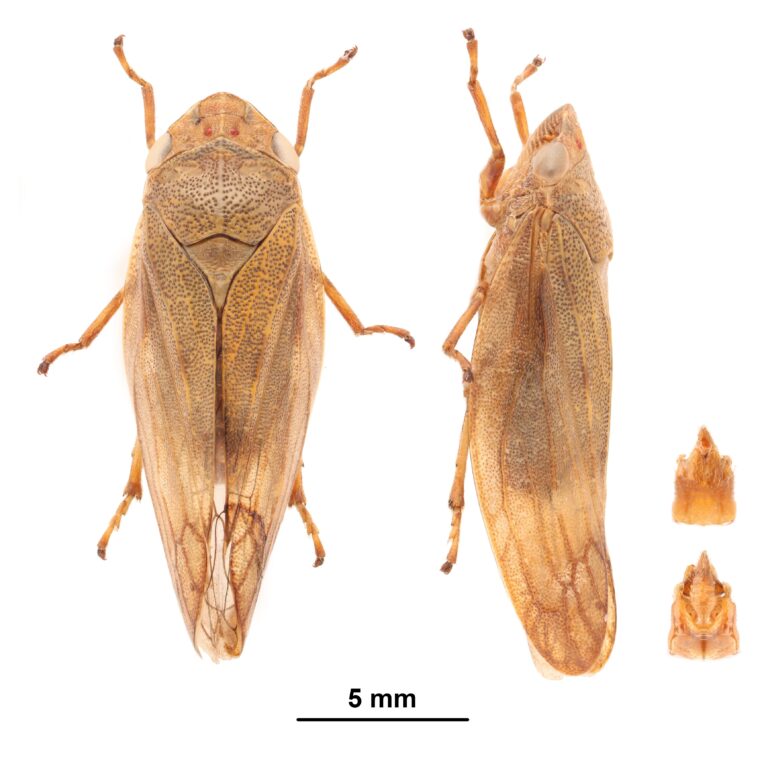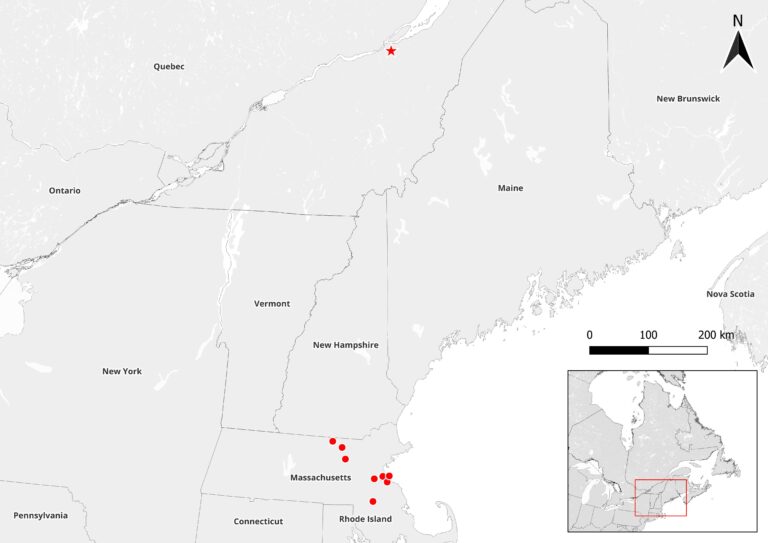
The genus Aphrophora (Aphrophoridae: Aphrophorinae) contains 77 species in the Palaearctic and Nearctic regions (Soulier–Perkins 2021). Of these, 13 are known from Canada (Maw et al. 2000; Wheeler & Hoebeke 2004). One of these species, Aphrophora alni (Fallén, 1805), is adventive in North America (Moore 1956), while the rest are native. Members of this genus are typically monophagous, feeding on deciduous (e.g. Salix, Populus, Tilia, Betula, Artemisia, Angelica) or coniferous (e.g. Abies, Larix, Pinus, Picea) trees or shrubs depending on the species (Komatsu, 1997). The willow spittlebug, Aphrophora salicina (Goeze, 1778), originates from Eurasia, where it is recognized as a common pest of willows (Salix sp.; Liang 2007). Larvae and adults feed on twigs and produce large spittle masses (Metcalf & Barber 1929). This species is reported for the first time in Canada based on eight specimens collected in Pintendre (Lévis, QC) by the author. These findings not only reveal a distribution gap in our understanding of Hemiptera fauna in Quebec and Canada but also contribute significantly to enhancing our comprehension of this taxonomic group.
Aphrophora salicina is distinguished from other species in this genus by its unicolorous wings, pointed head, and distinctive male genitalia (Fig. 1; Tishechkin 2023). First introduced in North America before 1921 (Metcalf & Barber 1929), this spittlebug has since exhibited limited dispersal in North America (Hamilton 1982). It remained primarily confined to Massachusetts (USA) based on open-source and validated citizen science observations (BugGuide 2024; iNaturalist 2024) and collection data (GBIF.org 2024; Harvard University 2024). This distribution pattern contrasts with the rapid spread of A. alni across eastern North America from the middle 20th Century onwards (Moore 1956). Six A. salicina individuals were collected in an exploited gravel area in Pintendre, south of the city of Lévis (QC, Canada). All Canadian specimens were obtained by beating live branches of Salix interior Rowlee growing at the base of a sandy-gravelly hill. This seems to support the species’ preference for willow trees in North America.
This discovery highlights a significant distribution gap in A. salicina distribution in North America, as it is nearly 450 km northeast in a straight line of its most northern distribution in Massachusetts (Fig. 2). This gap likely results from limited surveying of this insect group in Quebec and Canada. Hamilton (1982) anticipated the potential expansion of this aphrophorid species into southern Quebec and the Maritime Provinces. Moreover, the host plants of this species, black willow (Salix nigra Marshall) and meadow willow (Salix petiolaris Smith), identified by Metcalf & Barber (1929) in North America, are both present in Quebec. The introduction of this spittlebug in Canada might also be attributed to human-assisted transportation, considering the species’ historically low dispersal (Moore 1956). Further surveys focused on host plants in the vicinity of large cities may also clarify whether the species is widespread in southern Canada or exists as an isolated population in the country.
The author thanks Joel Kits and Robert Foottit (National Collection of Insects, Arachnids and Nematodes, Ottawa, ON) for kindly confirming the identification of A. salicina, as well as Nicolas Bédard (Natural Resources Canada, Quebec, QC) for providing the use of macro photography system.
BugGuide. 2024. BugGuide Advanced Search: Aphrophora salicina. https://bugguide.net/adv_search/bgsearch.php?taxon=1068213&location[]=MA accessed 2024-02-09.
GBIF.org. 2024. GBIF Occurrence Download. https://doi.org/10.15468/dl.p3w2m4, retrieved 2024-02-11.
Goeze J.A.E. 1778. Hemiptera. Entomologische Beyträge zu des ritter Linné Zwölften ausgabe des Natursystems. 2: 352 pp. Weidmanns Erben und Reich. https://www.biodiversitylibrary.org/page/24404521
Hamilton, K.G.A. 1982. The spittlebugs of Canada (Homoptera: Cercopidae). Insects and Arachnids of Canada Part 10. Biosystematics Research Institute, Ottawa, Ontario, Canada. 102 pp.
Harvard University. 2024. MCZBASE: The Database of the Zoological Collections. https://mczbase.mcz.harvard.edu/Specimens.cfm?execute=true&action=fixedSearch&any_taxa_term=Aphrophora%20salicis¤t_id_only=any accessed 2024-02-09.
iNaturalist. 2024. Aphrophora salicina. https://www.inaturalist.org/attachments/flow_task_outputs/8281252/observations-401234.csv.zip?1707668152 retrieved 2024-02-09.
Komatsu, T. 1997. A revision of the froghopper genus Aphrophora Germar (Homoptera, Cercopoidea, Aphrophoridae) from Japan Part 1. Japan Journal of Entomology 65: 81-96. https://cir.nii.ac.jp/crid/1520290885512647040
Liang, A.P. 2007. Synonymy of Aphrophora willemsi Lallemand 1946 with Aphrophora salicina (Goeze, 1778) (Hemiptera: Cercopoidea: Aphrophoridae). Journal of the New York Entomological Society 114(3): 140-143. https://doi.org/10.1664/0028-7199(2007)114[140:SOAWLW]2.0.CO;2
Maw, H.E.L., R.G. Foottit, K.G.A. Hamilton and G.G.E. Scudder. 2000. Checklist of the Hemiptera of Canada and Alaska. NRC Research Press, Ottawa, Ontario, Canada. 220 pp.
Metcalf, Z.P. and G.W. Barber. 1929. Notes on Aphrophora salicis de Geer in America. Psyche: A Journal of Entomology 36: 51-57.
Moore, T.E. 1956. Aphrophora alni in North America. Bulletin of the Brooklyn Entomological Society 51(1): 21. https://www.biodiversitylibrary.org/page/54947565
Soulier-Perkins, A. 2021. COOL–Cercopoidea organized online. http://rameau.snv.jussieu.fr/cool/index.php accessed 2024-01-27.
Tishechkin, D.Y. 2023. Review of the Aphrophora salicina (Goeze, 1778) (Homoptera: Cercopoidea: Aphrophoridae) species group of Russia and adjacent territories with description of a new species. Russian Entomology Journal 32(3): 253-260. https://doi.org/10.15298/rusentj.32.3.01
Wheeler, A.G. and E.R. Hoebeke. 2004. New records of Palearctic Hemiptera (Sternorrhyncha, Cicadomorpha, Heteroptera) in the Canadian maritime provinces. Proceedings of the Entomological Society of Washington 106(2): 298-406. https://www.biodiversitylibrary.org/page/30134861

Figure 1. Dorsal, lateral habitus and aedeagus of Aphrophora salicina, specimen LLC23AC03.

Figure 2. Geographical distribution of Aphrophora salicina in North America. The star represents first Canadian record and points the other North American records.